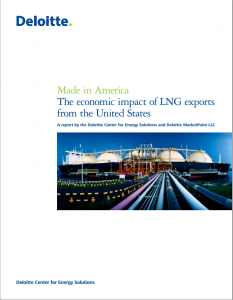Full Title: Made in America: The economic impact of LNG exports from the United States
Author(s): Deloitte Center for Energy Solutions
Publisher(s): Deloitte Center for Energy Solutions
Publication Date: January 1, 2011
Full Text: Download Resource
Description (excerpt):
Deloitte MarketPoint LLC (“DMP”) is pleased to provide an independent assessment of the potential economic impacts of LNG exports from the United States. Exporters might benefit from selling to foreign buyers, but how would such exports adversely impact domestic consumers of natural gas? Increased competition for supplies and accelerated resource depletion will likely raise domestic prices, but by how much? Will the level of exports being considered raise prices enough to cause economic damage as some objectors contend? After all, natural gas is a depletable resource, and what is exported is made unavailable to domestic uses. Under the assumptions outlined in this paper, we shall see that the magnitude of domestic price increase that results from export of natural gas in the form of LNG is likely quite small.
Some arguments in support of or objecting to LNG exports center around whether there are adequate resources to meet both domestic consumption and export volumes. That is, does the U.S. need the gas for its own consumption or does the U.S. possess sufficiently abundant gas volumes to provide for both domestic consumption and exports? In our view, this question only begins to address the export issue because simple comparisons of total available domestic resources to projected future consumption are insufficient to adequately analyze the economic impact of LNG exports. We believe the real issue is not only one of volume, but more of price impact. If price is not significantly affected, then scarcity and shortage of supply are not significant issues.
DMP applied its integrated North American Power, Coal, and World Gas Model (“WGM” or “Model”) to analyze the price and quantity impacts of LNG exports on the U.S. gas market. The WGM projects monthly prices and quantities over a 30-year time horizon based on rigorous adherence to accepted microeconomic theories. It includes disaggregated representations of North America, Europe, and other major global markets. The WGM computes prices and quantities simultaneously across multiple markets and across multiple time points. Unlike many other models which compute prices and quantities assuming all parties work together to achieve a single global objective, the WGM applies fundamental economic theories to represent self-interested decisions made by each market “agent” along every stage of the supply chain. More information can be obtained from DMP.
Vital to this analysis, the WGM represents fundamental producer decisions regarding when and how much reserves to add given the producer’s resource endowments and anticipated forward prices. This supply-demand dynamic is particularly important in analyzing the impact of demand changes (e.g., LNG exports) because without it, the answer will likely greatly overestimate the impact of demand changes by not adequately considering supply dynamics. Indeed, producers will anticipate the export volumes and resulting increased prices to make production decisions accordingly. LNG exporters might back up their multibillion dollar projects with long-term domestic supply contracts, but even if they do not, producers will anticipate and incorporate the demand growth in their production decisions. Missing this supply-demand dynamic is tantamount to assuming the market will be surprised and unprepared for the volume of exports and have to ration fixed supplies to meet the required volumes. Static models assume a fixed supply volume (i.e., productive capacity) during each time period and therefore are prone to overestimate the price impact of a demand change. Typically, users have to override this lack of supply response by manually adjusting supply to meet demand. Instead, the WGM uses sophisticated depletable resource logic in which today’s drilling decisions affect tomorrow’s price, and tomorrow’s price affects today’s drilling decisions. It captures the market dynamics between suppliers and consumers.
